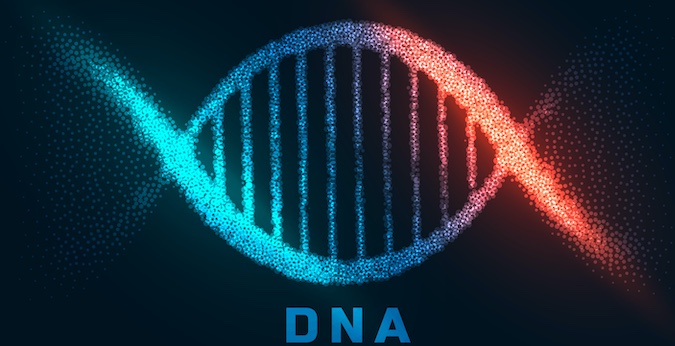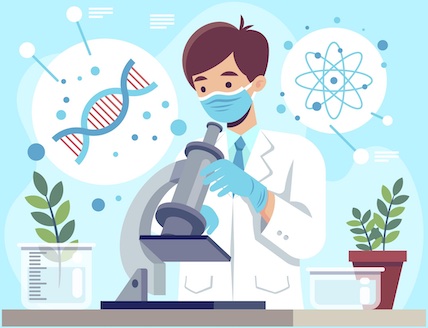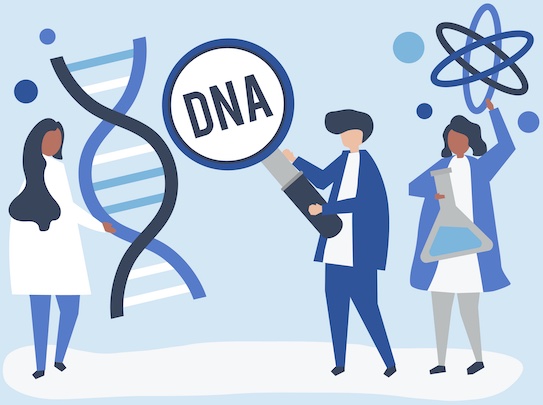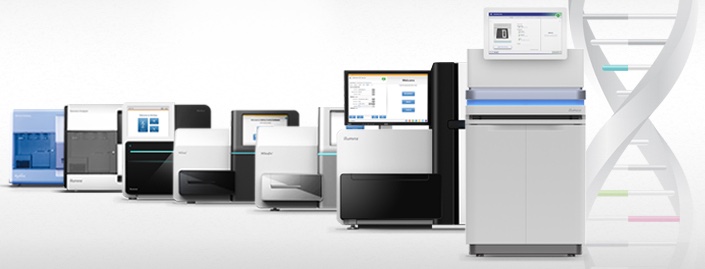
By Dr. Brandon Colby MD, a physician-expert in the fields of Clinical Genomics and Personalized Preventive Medicine.
Table Of Contents
- Sequencing Introduction
- Sequencing Meaning
- The Use of Sequencing
- Who Uses Sequencing?
- When Is the Right Time for Sequencing
- How Does Sequencing Work?
- Different Types of Sequencing
- Genome Sequencing Cost
- Genome Sequencing Companies
- Where To Order Sequencing Online
- References
- About The Author
Sequencing Introduction
Our DNA — short for deoxyribonucleic acid — is the foundation of our identity. A single molecule contains all the genetic information necessary for our cells to replicate and maintain our body functioning properly.
DNA was somewhat of a mystery for most of recorded history. In 1869, a Swiss chemist called Friedrich Miescher first identified a compound he called “nuclein” inside human white blood cells. Nearly a century later, in 1952, Rosalind Franklin was able to produce high-resolution photographs of the DNA strand.1
The following year, James Watson and Francis Crick used Franklin’s photographs to discover the famous double helix structure of DNA. In 1977, Frederick Sanger invented the Sanger sequencing method — but it wasn’t until 2003 that The Human Genome Project was completed.

The Human Genome Project was a large-scale genomics project, conducted from many different countries around the world, with the aim of sequencing the entire human DNA sequence for the first time. The Human Genome Project took 13 years to complete, and it was a groundbreaking step in the field of human genetic research.
In recent years, DNA sequencing technology has become more and more accessible. As new methods have been discovered, it has become possible for anyone to have their DNA sequenced for only a few hundred dollars. This has opened a wide range of possibilities in many different fields, from personalized medicine to scientific research.
Read on if you want to learn everything there is to know about sequencing.
Sequencing Meaning
Base pairs are the fundamental unit of DNA. They are formed by molecules called nucleotides, which are located on opposite sides of the double helix structure, and bound together to form a “step” of the DNA ladder.
Four different nucleotides can be found in human DNA and form base pairs: adenine (A), cytosine (C), guanine (G), and thymine (T). Long sequences of these pairs form chromosomes and DNA.2
The purpose of sequencing is to determine the exact order in which each of these base pairs exists in our genetic code.
What Is The Purpose Of Sequencing?

The order in which base pairs are arranged determines the functioning of our genes, the traits we exhibit, our ancestry and ethnic background, our metabolism, and even our risk for many diseases.
Sequencing can detect a wide range of genetic variants; the most common type of variant is called a single nucleotide polymorphism (SNP). As their name suggests, SNPs represent a variation in a single nucleotide in a DNA strand. SNPs are a normal part of the human genome, which can contain 4 to 5 million different SNPs on average.3
SNPs act as biological markers, and they can help scientists compare different DNA samples to each other to find both differences and similarities. When SNPs affect regulatory genes, they can impact an individual's health or disease risk.
Sequencing can find other types of genetic variations, including:
- Structural Variations (SVs)
- Copy-number variation (CNV)
- Insertion and deletions (INDELs)
- Mitochondrial Heteroplasmy (MITO)
Decoding the sequence of the human genome has allowed science to better understand evolution, genetic inheritance, health, and many diseases. These technologies have made it possible for numerous molecular diagnostics tests, medications, and therapeutic procedures to be developed, and they’ll surely continue to contribute to scientific research for many years to come.
What Is A Sequence?
Simply put, a DNA sequence is the order in which base pairs are arranged in a section of your DNA. As we mentioned above, human DNA contains four different types of nucleotides: adenine (A), cytosine (C), guanine (G), and thymine (T).
DNA has two strands that form the double helix structure; to achieve this shape, hydrogen bonds unite two bases on opposite strands, creating a base pair. Each nucleotide forms specific base pairs: A pairs up with T, and C pairs with G.4 Sequencing is used to determine the order or sequence in which these pairs are arranged.
DNA sequences are read in triplets — for example, ATG. Since bases are complementary and always join the same pair, it’s possible to deduce the partner triplet that corresponds to ATG on the opposite strand, which would be TAC.
Genotyping vs. Sequencing
If you’re interested in the field of genomics, you may have heard the terms “genotyping” and “sequencing”. While these two terms both refer to DNA testing, they can’t be used interchangeably, since they involve very different processes.
Genotyping is a process that identifies which genetic variants are present in someone’s DNA. This method analyzes specific locations in your genetic code where mutations commonly occur. A genotyping chip or microarray is often used for this purpose.
Sequencing, on the other hand, is used to determine the order of the base pairs that make up an entire genome. As a result, it can detect genetic variations in virtually every part of the human genome.
Why Sequencing Is Better Than Genotyping
Genotyping can only be used to identify the presence of known variants rather than new mutations. And unlike DNA sequencing methods, genotyping only reads specific portions of your DNA looking for said variants. Genotyping uses devices called microarrays or chips.
Genotyping can still be very useful, especially if you already know which genetic variation you’re looking for. For example, someone with a family history of a certain genetic disorder could use a simple genotyping test if they only want to determine the presence of that variant.5
However, it’s undeniable that sequencing can provide a lot more information than genotyping microarrays. Sequencing looks through all the base pairs in a specific DNA sequence, which allows it to identify any type of variant — whether science has already discovered its significance or not. This thoroughness means that DNA sequencing can detect much more detailed and individual genetic information.
Let’s review some of the uses of DNA sequencing.
The Use of Sequencing

A genome sequence can be obtained for many different reasons. The information gathered through this genetic testing method can be used to advance research, diagnose patients, create public health strategies, and understand infectious disease better.
Here are some of the most common uses of sequencing DNA.
Screening For Rare Diseases
Extremely rare diseases may only affect a few hundred individuals, or even just specific family groups in the entire world.
Diagnosing these diseases and identifying the mechanism that causes them can be extremely challenging. It’s also frequent for patients with rare diseases to be misdiagnosed at first, since it’s normal for physicians to initially try to rule out more common causes. But at the same time, a delayed diagnosis can lead to poor outcomes for these patients.
Genetic testing, particularly whole genome sequencing, can be extremely helpful in these cases. Since WGS reads the entire genome, it can detect any abnormalities that may be causing a rare disease. Knowing which genetic abnormality is causing a patient’s symptoms is the first step in learning more about the disease and how it can be treated.6
WGS can also determine your carrier status for many genetic diseases. Even if you don’t have a disease yourself, learning this information can be very helpful for future family planning.
Newborn Screening
The quality of care a baby receives when they’re born can have long-lasting consequences on their future health and development. Newborn screening is a routine procedure that detects dozens of different diseases soon after a baby is born, even if they’re asymptomatic and healthy at the time of their birth. The conditions diagnosed by this screening panel include:
- Amino acid disorders
- Fatty acid oxidation disorders
- Sickle cell disease
- Thalassemia
- Cystic fibrosis
- Galactosemia
- Congenital hypothyroidism
- Congenital adrenal hyperplasia
Thanks to new and more affordable DNA sequencing technologies, newborn screening could supplement traditional newborn screening in the near future.
The incorporation of whole genome sequencing (WGS) to newborn screening could allow doctors and parents to have access to a much wider range of information about the new baby. This will potentially result in a broader diagnosis, improved care, and a better quality of life for children who are diagnosed with a disease shortly after birth.
It’s very likely that genetic screening will become the norm in the not-so-distant future. In fact, countries such as the United Kingdom have already expressed their intention to offer routine DNA tests to their citizens.7
Preventive Medicine
In addition to determining your carrier status for many genetic diseases, sequencing can also assess your risk for different preventable conditions. Many illnesses are multifactorial, which means that their development depends on a combination of genetic, lifestyle, and environmental factors. Common multifactorial diseases include:
- Heart disease
- Diabetes
- Hypertension
- Alzheimer’s disease
- Asthma
- Thyroid disease
- Obesity
- Different types of cancer
- Arthritis
- Autoimmune disorders
Even if you can’t modify your genetic predisposition for these diseases, identifying your genetic disease risks can put you on the right track to prevent them.8 Through genetic testing, personalized medicine can provide customized preventive strategies that are more effective for you.
Pharmacogenomics is another branch of genetic medicine that will probably become much more popular in the near future. Through DNA sequencing, you can obtain a full pharmacogenomic profile that will tell you how you may react to specific medications and whether you’re likely to suffer adverse reactions after taking them. This will undoubtedly make it easier for physicians to prescribe treatments that fit every patient perfectly.
Detecting Difficult To Diagnose Illnesses
Not every medical diagnosis is straightforward. In some cases, the symptoms a patient displays can baffle an entire healthcare team. But unfortunately, a delayed diagnosis leads to delayed treatment, which can have serious repercussions on the health and life of patients.
More than 7,800 different diseases are currently known to have a Mendelian pattern of inheritance, but we only know the exact genetic cause of approximately 4,000 of those conditions. That means that, at any point in time, hundreds of thousands of people around the world could be suffering from complex diseases that can’t be easily diagnosed.
DNA sequencing is able to determine the exact genetic cause of a patient’s illness, thus providing a quick and accurate diagnosis for rare diseases. The incorporation of DNA sequencing to molecular diagnostics panels can make it possible for these patients to receive treatment sooner, thus improving their prognosis and quality of life.
Genetic Genealogy
Wanting to learn more about where we come from is a natural human urge that has always existed. Up until recently, those who were interested in genealogy were only able to trace their family tree through painstaking research, which often led to brick walls or dead ends that couldn’t be solved.
Thanks to DNA testing, anyone can discover their ancestry from the comfort of their own home. Your DNA information can be used to determine ethnicity estimates, familial relationships, and even migratory patterns. Genetic genealogy makes it possible for brick walls to be torn down so that people can discover more extensive and thorough family trees.
Genetic genealogy is often used in combination with traditional genealogy research methods, which include:
- Document research
- Birth certificates
- Marriage and divorce records
- Death certificates
- Newspaper articles
- Religious records
- Adoption records
- Census records
- Medical records
- Court records
- Oral interviews
- Diaries or personal letters
- Photographs
- Tombstones
DNA tests compare the SNPs in a sample to many reference genomes in a database. Since specific SNPs can be commonly found among certain ethnic groups, identifying the SNPs in your DNA can provide ethnicity estimates.
When you upload your genetic information to different websites, you’ll also have the opportunity to be matched with other users who share some portion of your DNA so you can create your family tree.
Who Uses Sequencing?

Thanks to its wide range of applications, DNA sequencing has quickly gained popularity in many different professional fields. Anyone can benefit from discovering their DNA sequence, and below, you’ll find some of the fields in which sequencing is most useful.
Doctors and Healthcare Professionals
Physicians can use sequencing data to provide personalized treatment to their patients. As a result, next-generation sequencing technology is making it possible for patients to receive a higher quality of care than ever before. Thanks to fields such as pharmacogenomics, for example, a patient can now be prescribed a medication that will work for their condition knowing that it won’t cause side effects.
It’s also important for doctors to use genetic data to ascertain every patient’s disease risk. Having a genetic predisposition to a single, severe disease can have a significant impact on anyone’s wellbeing, and sequence data can be used to tailor preventive treatments for each patient.
Genomics also has a wide range of applications in the field of public health. Every population is different and has different needs — the DNA of a community can help public health institutions and researchers understand these needs better so they can create public health initiatives that are more effective.9 The possible benefits of genomics in the field of public health include:
- Ability to create public health initiatives that are tailored to the needs of specific communities.
- Enhanced understanding of infectious diseases and how to prevent them.
- Identification of disease risks that affect a population group.
DNA testing can also save money and strengthen healthcare systems, since diagnosing patients quickly and accurately can save resources, shorten waitlists, and reduce the workload for healthcare professionals.
Wellness Services
Sequencing can reveal information pertaining to many different aspects of your life, down to how you metabolize certain nutrients. Sequencing can also provide insights regarding your sleep habits, skin care needs, mood, longevity estimates, and diet and exercise recommendations, among many others.
Your genes contain information pertaining to all of these areas in your life and more. A DNA test result could tell you which foods will help you lose weight, how your response to stress is conditioned by your DNA, and even what to do so you can sleep better at night. After identifying your disease risks and wellness insights, you’ll be able to make choices that lead to a healthier and more enjoyable lifestyle.
Researchers
DNA sequencing is routinely used in scientific research and large scale clinical studies. Sequencing the human genome has a wide range of applications in clinical research, from better understanding the cause of disease to creating new treatments, and even performing prenatal testing.10 It’s very likely that future medical breakthroughs will rely on sequencing data
The more human genomes are sequenced, the more exact the science behind this process will become. New sequences help build stronger, more thorough databases that can be compared against each other to identify common variants, ethnic characteristics, and genetic risk factors, among other findings.
These scientific discoveries can be used by researchers to advance new diagnosis and therapeutic procedures, medications, and preventive measures. Research into many diseases also aims to discover exactly which gene contains the regulatory elements that cause or prevent a disease, hoping to develop treatments that target these genetic elements.
DNA sequencing technology can be used to sequence the genome of any living being, including many types of pathogens. These technologies can be used on viruses, bacteria, fungus, and other microorganisms to identify their pathogenic mechanisms, origin, and evolution. Sequencing is partly the reason why we have COVID-19 vaccines that are safe and effective!
Professional Genealogists
As we stated above, genetic genealogy is a powerful tool when used in combination with traditional family history research methods. Anyone can research their family line, of course — but professional genealogists have extensive knowledge that helps them infer familial relationships with the help of both DNA testing and traditional research.
Forensic Investigators
Modern sequencing methods only require a small amount of DNA to be able to produce high-quality results. Since the advent of DNA profiling, many previously cold cases have been solved thanks to a breakthrough in the genetic evidence associated with the case.
DNA sequencing has made it possible for cases to be solved even after many years. In some cases, family members of a perpetrator have unknowingly uploaded their genetic data to a genealogy website, allowing investigators to match their DNA to the genetic data found at a crime scene. Then, DNA analysis of the suspect can be used to confirm the match.
When Is the Right Time for Sequencing?
If you ask us, the right time for sequencing is now! With affordable prices and international shipping, obtaining your DNA sequence has become easier than ever.
You could even get your DNA sequenced once and store the resulting sequence data to keep analyzing it in the future, as new sequencing techniques become available. You can also upload your raw DNA data to many different online platforms to access numerous health, ancestry, and wellbeing reports and insights — even if you didn’t use that provider’s testing kit.
How Does Sequencing Work?

Sequencing technology has come a long way since Sanger sequencing was first invented. Sequencing methods work very differently from one another, but they all usually break stretches of DNA into smaller pieces so the analysis can be performed.
First-generation sequencing
In traditional DNA sequencing methods, such as Sanger sequencing, the molecules were first cloned into a prokaryotic plasmid and amplified within bacteria. Then, a primer was added to a denatured DNA fragment. This activated the synthesis of a single-stranded polynucleotide with the addition of an enzyme called DNA polymerase.
Modified nucleotides, called dideoxynucleotides, truncated the activity DNA polymerase, resulting in chain-termination and smaller DNA fragments. The completed fragments are separated using capillary electrophoresis and analyzed.
Sanger sequencing is still used to analyze shorter DNA molecules in low volumes. This method is highly accurate, despite its shortcomings. But it would be impossible to analyze large amounts of DNA bases quickly using Sanger sequencing, which is where modern sequencing technologies come into play.
Next-generation sequencing
Next-generation sequencing (NGS) or high-throughput sequencing methods have largely replaced first generation sequencing technologies, thanks in large part to their affordability and fast turnaround times.
NGS skips the step in which DNA is amplified inside bacteria — instead, some NGS methods use PCR to amplify DNA. NGS platforms are able to analyze large amounts of DNA in parallel.
Sequencing reactions break DNA samples into smaller pieces, thus generating many short read sequences. Then, bioinformatics software is used to piece these sequences back together and assemble the completed read, which is later annotated with relevant findings. NGS methods still undertake certain traditional steps, such as DNA template generation and parallelization.
Modern genetic test results can be delivered in a matter of weeks. In fact, smaller and more portable sequencer machines are currently being developed with the aim of making sequencing available in any corner of the world.
Many different types of high-throughput sequencing methods have been developed, including:
- Sequencing by synthesis (Illumina)
- Dye sequencing (Illumina)
- Pyrosequencing (454 Life Sciences)
- Single-molecule real-time sequencing (Pacific Biosciences)
- Nanopore technology sequencing
- Sequencing by ligation (SOLiD sequencing)
- Combinatorial probe anchor synthesis (cPAS- BGI/MGI)
- Ion semiconductor (Ion Torrent sequencing)
Different Types of Sequencing
Different methods can be used for DNA sequencing If you’re interested in sequencing, it’s important to understand the differences between these methods so you can choose a provider that offers exactly what you need.
Sequencing DNA
Interestingly, next-generation sequencing (NGS) isn’t just used for DNA sequencing. Ribonucleic acid (RNA) can also be sequenced. RNA sequencing or RNA-seq can help identify biomarkers, infer medication pathways, and assist in molecular diagnostics. Although DNA is the single-molecule that contains our genetic data, single-stranded RNA forms the transcriptome of the human genome — that is, the instructions that regulate DNA replication.
However, DNA sequencing has the most clinical applications. Now, let’s discuss some of the different methods that can be used to sequence DNA.
Full Genome Sequencing
Whole genome sequencing (WGS), which is also known as entire genome sequencing, is the most complete type of DNA sequencing currently available. This method is used to sequence the entirety of the human genome, including both coding and non-coding DNA. Our DNA contains approximately 3 billion base pairs, and although it may seem impossible, whole genome sequencing performs analysis on each one.
The thoroughness of this test ensures that it doesn’t miss any genetic variants, large or small, that may be skipped over by more targeted methods. Modern sequencer machines are able to complete the sequence of an entire genome faster and more accurately than ever.
Exome Sequencing
All parts of your DNA are important, but they don’t play the same roles. Certain parts of your genetic sequence contain instructions for the production of many different proteins — this is called coding DNA, or exons. Your exome is the combination of all the exons in your DNA.
There’s also non-coding DNA, which — as its name suggests — doesn’t contain instructions for protein synthesis. However, that doesn’t mean that non-coding DNA is meaningless.11 Although we still don’t fully understand all the functions of non-coding DNA, we know that it:
- Provides binding sites for proteins that regulate the process of DNA transcription.
- Contains instructions for RNA formation, including transfer RNA (tRNA) and ribosomal RNA (rRNA).
- Forms telomeres at the end of each chromosome to protect the entirety of the DNA sequence.
- Helps regulate gene expression.
Whole exome sequencing (WES) is a sequencing method that only determines the order of the DNA bases in your exome, rather than your whole genome. However, WES still provides plenty of information that can be useful if you want to learn more about your genetic code.
Whole Exome Sequencing vs Targeted Exome Sequencing
Targeted exome sequencing uses a “hot-spot” or targeted sequencing panel to focus the test on specific coding regions or genes of interest. The assay uses oligonucleotide primer pairs to amplify specific regions of DNA, rather than the entire genome.
Targeted sequencing produces a greater sequencing depth that can identify low-frequency variants associated with disease. Targeted exome sequencing is most often used in clinical settings in which the objective is simply to confirm a diagnosis, rather than screening for many different diseases and traits.
Whole Genome Sequencing vs Whole Exome Sequencing
As you may suspect, one of the main shortcomings of WES is that it doesn’t analyze important portions of non-coding DNA, which can include variants that are still relevant to many processes inside the human body.
WGS, on the other hand, is used to sequence each and every single nucleotide in the human genome. As we stated above, non-coding DNA fragments also play an important role, which is why sequencing it is just as important as sequencing the rest of your DNA.
Research also shows that WGS is more powerful than WES to detect genetic variants in the exome itself, thus making it a more accurate test.12
Short Read vs Long Read Sequencing
Newer sequencing methods can be short read or long read. As you may have guessed, short read (next generation) and long read (third-generation) sequencing refer to the length of the DNA fragments that each method can process at once. By performing analysis on longer stretches of DNA, these new methods could make the process even faster.
Next-generation sequencing methods have revolutionized DNA sequencing, but they still produce relatively short reads. Third-generation sequencing technologies, or long read sequencing, are currently being developed in the hopes of making DNA sequencing even faster and more portable.
Although long read sequencing is still prone to high error rates, it’s expected to keep improving in the near future.13 Soon, long read sequencing methods could become the norm and outperform existing sequencing technologies.
Genome Sequencing Cost

When sequencing technologies were first invented, they were slow and incredibly expensive. Sanger sequencing, which was the first method to be widely used for sequencing, was only able to perform short read DNA analysis. The Human Genome Project was an incredibly expensive project, costing more than $2.7 billion spread out over more than a decade of work.
But as next-generation sequencing platforms have become available to a wider audience, prices have dropped significantly. The race for the “$1,000 genome” started in 2001, with companies working tirelessly to come up with new technologies that would sequence whole human genomes for $1,000 or less.14
Although it seemed impossible at the time, biotechnology companies such as 454 Life Sciences, Pacific Biosciences, Illumina, Complete Genomics, Helicos Biosciences, Thermo Fisher Scientific, Sequencing.com, Dante Labs, Nebula Genomics, Oxford Nanopore Technologies, and many others joined the effort to achieve this goal. As a result, genome sequencing cost has dramatically decreased over the past two decades.
Nowadays, it’s possible to simply order a direct-to-consumer DNA testing kit, take a sample at home, and receive your sequencing results for just a few hundred dollars.
Genome Sequencing Companies
Now that you know just how useful DNA sequencing can be, it probably won’t come as a surprise to learn that many different biotechnology companies have started to offer sequencing services over the past few years.
Some companies only offer DNA sequencing tests through a physician, or they require a doctor’s prescription in order to perform the test. Other companies provide direct-to-consumer testing and will ship a testing kit to practically any country in the world.
If you’re interested in obtaining your DNA sequence, it’s important to research providers beforehand. A good company won’t just offer high-quality results — they’ll also provide thorough insight reports, protect your data, help you understand your genetic data analysis, and feature different reports based on this data. It’s also important to choose a provider that uses methods that achieve a high-quality sequencing depth, such as 30x, to ensure accurate data.
Some of the most renowned providers of DNA sequencing include:
Sequencing.com
Sequencing.com offers two high-quality sequencing tests at very affordable prices: the Ultimate DNA Test and the Ultimate Genome Sequencing.
The Ultimate DNA Test uses advanced microarray technology to analyze more than 30 million genetic variants. Meanwhile, the Ultimate Genome Sequencing performs clinical-grade 30x whole genome sequencing that gathers information from your entire genome, including carrier screening for over 2,000 diseases. Through our DNA App Store, you can access numerous reports that will give you insights into many areas of your life.
Invitae
Invitae, previously CombiMatrixCorp, employs the CombiSNP Array to perform customized exome sequencing. Their tests are available to individuals and providers alike. They offer different tests, including a carrier screen, cancer screen, cardio screen, and diagnostic tests with prices that range from $250 to $350.
Invitae tests don’t detect large copy number variations (cytogenetic events), INDELs, or mosaic/somatic events, and they don’t analyze mitochondrial DNA.
Fulgent Genetics
Fulgent Genetics offers a variety of genetic tests, including WGS/WES, RNA sequencing, methylation WGS, mitochondrial DNA sequencing, and tumor profiling, among others. The company provides prices on request.
Ambry Genetics
Ambry Genetics offers exome sequencing and mitochondrial genome sequencing tests that can be further targeted to specific diseases and genes, such as hereditary leiomyomatosis and renal cell cancer (HLRCC), maturity-onset diabetes of the young (MODY), cystic fibrosis, multiple endocrine neoplasia, Peutz-Jeghers syndrome, and neurofibromatosis type 1, among others. Ambry Genetics tests may be covered by insurance, or cost several hundred dollars each.
GeneDx
GeneDx specializes in the use of high throughput sequencing to diagnose rare and ultra-rare genetic diseases. They offer mutation-specific testing, hereditary cancer screening, prenatal screening, cardiovascular analysis, among many other highly specialized tests. Certain tests may be partially or fully covered by insurance, and the company also offers installment payment plans.
Nebula Genomics
Nebula Genomics offers 30x WGS for approximately $300 through their website. The company also provides access to different reports and an online research library.
Dante Labs
Dante Labs offers whole genome sequencing through their direct-to-consumer kits. Each kit costs approximately $600, and different reports are available through their website.
Illumina
Illumina was one of the pioneers in the field of genomics and next generation sequencing, and they still produce many of the sequencing machines used by other companies. The company doesn’t offer genetic testing directly; instead, it provides kits and products to healthcare providers and other biotechnology companies.
WuXi NextCODE
WuXi NextCode, which has been rebranded as Genuity Science, offers genomics, artificial intelligence-driven data sourcing and data analysis services to pharmaceutical companies.
Does 23andMe Perform Sequencing?
No. 23andMe uses genotyping to process your DNA information and provide ancestry and health reports. 23andMe performs genetic analysis on your autosomal DNA, sex chromosomes (X and Y), and mitochondrial DNA (mtDNA) to find specific SNPs.
Does Ancestry.com Perform Sequencing?
No. Ancestry.com uses autosomal DNA testing, and it usually examines approximately 1 million SNPs out of 3 billion possible base pairs.
Does MyHeritage Perform Sequencing?
No. MyHeritage performs microarray-based autosomal DNA testing.
Where To Order Sequencing Online?
Sequencing.com's Ultimate Genome Sequencing
If you want to take the most comprehensive type of DNA test available, Sequencing.com. offers whole genome sequencing for just $399.
You can also upload the raw data obtained from other testing providers to the Sequencing.com platform to access additional reports and insights.
References
- The History of DNA Timeline. DNA Worldwide. Retrieved April 11, 2021.
- Base Pair. NIH National Human Genome Research Institute. Retrieved April 14, 2021.
- What are single nucleotide polymorphisms (SNPs)? MedlinePlus. Retrieved April 10, 2021.
- Medical Definition of DNA sequence. MedicineNet. Retrieved April 15, 2021.
- Griffiths, A. J.F. (2012, July 5). DNA sequencing. Encyclopedia Britannica.
- Posey, J.E. Genome sequencing and implications for rare disorders. Orphanet J Rare Dis 14, 153 (2019).
- DNA testing on the NHS to fast track diagnosis for critically ill babies and children. (2020, January 3). NHS. Retrieved April 14, 2021
- Hallie, L. (2020, January 13). Cracking the Genetic Code: Why Gene Sequencing May Hold the Key to Intercepting Diseases Before They Start. Johnson & Johnson. Retrieved April 14, 2020, from
- What is Whole Genome Sequencing? (2018, May 1). Public Health Matters. Retrieved April 15, 2021.
- Di Resta, C., & Ferrari, M. (2018). Next Generation Sequencing: From Research Area to Clinical Practice. EJIFCC, 29(3), 215–220.
- What is noncoding DNA? Medline Plus. Retrieved April 10, 2021
- Comparison of WGS and WES to detect exome variants. Aziz Belkadi, Alexandre Bolze, Yuval Itan, Aurélie Cobat, Quentin B. Vincent, Alexander Antipenko, Lei Shang, Bertrand Boisson, Jean-Laurent Casanova, Laurent Abel. Proceedings of the National Academy of Sciences Apr 2015, 112 (17) 5473-5478.
- Adewale B. A. (2020). Will long-read sequencing technologies replace short-read sequencing technologies in the next 10 years?. African journal of laboratory medicine, 9(1), 1340.
- DePristo M. A. (2010). The $1,000 Genome: The Revolution in DNA Sequencing and the New Era of Personalized Medicine. American Journal of Human Genetics, 87(6), 742.
About The Author
Dr. Brandon Colby MD is a US physician specializing in the personalized prevention of disease through the use of genomic technologies. He's an expert in genetic testing, genetic analysis, and precision medicine. Dr. Colby is also the Founder of Sequencing.com and the author of Outsmart Your Genes.
Dr. Colby holds an MD from the Mount Sinai School of Medicine, an MBA from Stanford University’s Graduate School of Business, and a degree in Genetics with Honors from the University of Michigan. He is an Affiliate Specialist of the American College of Medical Genetics and Genomics (ACMG), an Associate of the American College of Preventive Medicine (ACPM), and a member of the National Society of Genetic Counselors (NSGC).